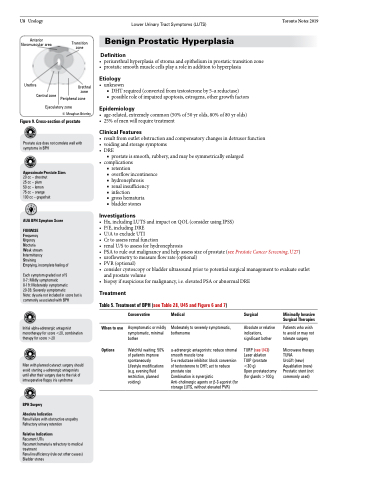Page 1326 - TNFlipTest
P. 1326
U8 Urology
Lower Urinary Tract Symptoms (LUTS)
Toronto Notes 2019
Anterior fibromuscular area
Transition zone
Benign Prostatic Hyperplasia
Definition
• periurethralhyperplasiaofstromaandepitheliuminprostatictransitionzone • prostaticsmoothmusclecellsplayaroleinadditiontohyperplasia
Etiology
• unknown
■ DHTrequired(convertedfromtestosteroneby5-αreductase)
■ possible role of impaired apoptosis, estrogens, other growth factors
Epidemiology
• age-related,extremelycommon(50%of50yrolds,80%of80yrolds) • 25%ofmenwillrequiretreatment
Clinical Features
• resultfromoutletobstructionandcompensatorychangesindetrusorfunction • voidingandstoragesymptoms
• DRE
■ prostate is smooth, rubbery, and may be symmetrically enlarged • complications
■ retention
■ overflowincontinence ■ hydronephrosis
■ renal insufficiency
■ infection
■ gross hematuria
■ bladder stones
Investigations
• Hx,includingLUTSandimpactonQOL(considerusingIPSS) • P/E,includingDRE
• U/AtoexcludeUTI
• Cr to assess renal function
• renal U/S to assess for hydronephrosis
• PSAtoruleoutmalignancyandhelpassesssizeofprostate(seeProstateCancerScreening,U27)
• uroflowmetrytomeasureflowrate(optional)
• PVR(optional)
• considercystoscopyorbladderultrasoundpriortopotentialsurgicalmanagementtoevaluateoutlet
Urethra Urethral
Central zone zone Peripheral zone
Ejaculatory zone
© Meaghan Brierley
Figure 9. Cross-section of prostate
Prostate size does not correlate well with symptoms in BPH
Approximate Prostate Sizes
20 cc – chestnut 25cc–plum
50 cc – lemon
75 cc – orange 100 cc – grapefruit
AUA BPH Symptom Score
FUNWISE
Frequency
Urgency
Nocturia
Weak stream
Intermittency
Straining
Emptying, incomplete feeling of
Each symptom graded out of 5
0-7: Mildly symptomatic
8-19: Moderately symptomatic
20-35: Severely symptomatic
Note: dysuria not included in score but is commonly associated with BPH
Initial alpha-adrenergic antagonist monotherapy for score <20, combination therapy for score >20
Men with planned cataract surgery should avoid starting α-adrenergic antagonists until after their surgery due to the risk of intraoperative floppy iris syndrome
BPH Surgery
Absolute Indication
Renal failure with obstructive uropathy Refractory urinary retention
Relative Indications
Recurrent UTIs
Recurrent hematuria refractory to medical treatment
Renal insufficiency (rule out other causes) Bladder stones
and prostate volume
• biopsyifsuspiciousformalignancy,i.e.elevatedPSAorabnormalDRE
Treatment
Table 5. Treatment of BPH (see Table 28, U45 and Figure 6 and 7)
When to use
Options
Conservative
Asymptomatic or mildly symptomatic, minimal bother
Watchful waiting: 50% of patients improve spontaneously Lifestyle modifications (e.g. evening fluid restriction, planned voiding)
Medical
Moderately to severely symptomatic, bothersome
α-adrenergic antagonists: reduce stromal smooth muscle tone
5-α reductase inhibitor: block conversion of testosterone to DHT; act to reduce prostate size
Combination is synergistic Anti-cholinergic agents or β-3 agonist (for storage LUTS, without elevated PVR)
Surgical
Absolute or relative indications, significant bother
TURP (see U43) Laser ablation TUIP (prostate <30 g)
Open prostatectomy (for glands >100g
Minimally Invasive Surgical Therapies
Patients who wish to avoid or may not tolerate surgery
Microwave therapy TUNA
UroLift (new) Aquablation (new) Prostatic stent (not commonly used)


